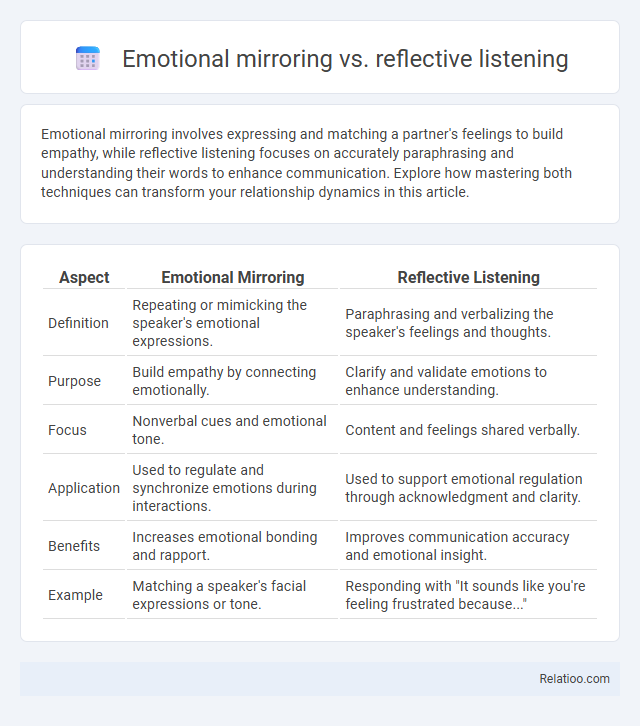Emotional mirroring involves expressing and matching a partner's feelings to build empathy, while reflective listening focuses on accurately paraphrasing and understanding their words to enhance communication. Explore how mastering both techniques can transform your relationship dynamics in this article.
Table of Comparison
| Aspect | Emotional Mirroring | Reflective Listening |
|---|---|---|
| Definition | Repeating or mimicking the speaker's emotional expressions. | Paraphrasing and verbalizing the speaker's feelings and thoughts. |
| Purpose | Build empathy by connecting emotionally. | Clarify and validate emotions to enhance understanding. |
| Focus | Nonverbal cues and emotional tone. | Content and feelings shared verbally. |
| Application | Used to regulate and synchronize emotions during interactions. | Used to support emotional regulation through acknowledgment and clarity. |
| Benefits | Increases emotional bonding and rapport. | Improves communication accuracy and emotional insight. |
| Example | Matching a speaker's facial expressions or tone. | Responding with "It sounds like you're feeling frustrated because..." |
Understanding Emotional Mirroring
Emotional mirroring involves recognizing and subtly replicating another person's emotional expressions to build empathy and trust, while reflective listening focuses on verbally restating the speaker's content to confirm understanding. Understanding emotional mirroring helps you connect more deeply by validating feelings non-verbally, which enhances emotional rapport beyond mere words. This technique fosters a meaningful emotional exchange that can improve communication and strengthen relationships.
Defining Reflective Listening
Reflective listening is a communication technique where the listener actively interprets and restates the speaker's messages to confirm understanding and foster empathy. Unlike emotional mirroring, which involves directly echoing the speaker's emotions and body language to create rapport, reflective listening emphasizes verbal feedback that clarifies thoughts and feelings. This method enhances emotional intelligence by encouraging deep engagement with the speaker's perspective and promoting mutual understanding.
Core Principles of Emotional Mirroring
Emotional mirroring centers on validating and acknowledging Your feelings by subtly reflecting your emotional state through body language and tone, enhancing empathy and connection. Unlike reflective listening, which emphasizes paraphrasing spoken content to clarify and confirm understanding, emotional mirroring targets unspoken emotional cues and fosters emotional bonding. Core principles of emotional mirroring include genuine empathy, nonverbal synchronization, and emotional attunement, creating a safe space for authentic expression and emotional resonance.
Key Elements of Reflective Listening
Reflective listening centers on actively understanding and validating the speaker's emotions by paraphrasing and summarizing their thoughts, which fosters empathy and connection. Key elements include attentive listening, accurately reflecting feelings and content without judgment, and encouraging openness through non-verbal cues. Unlike emotional mirroring that primarily mimics emotions and body language, reflective listening emphasizes cognitive engagement and clarifies the speaker's message to deepen mutual understanding.
Emotional Mirroring in Everyday Conversation
Emotional mirroring involves subtly matching another person's emotional expressions and body language to create rapport and empathy during everyday conversations. Reflective listening, by contrast, emphasizes verbally paraphrasing or summarizing the speaker's message to demonstrate understanding and clarify meaning. Prioritizing emotional mirroring in daily interactions fosters deeper emotional connections, enhances trust, and improves communication effectiveness without interrupting the speaker's flow.
Reflective Listening Techniques for Effective Communication
Reflective listening techniques enhance effective communication by actively focusing on your partner's emotions and thoughts, verifying understanding through paraphrasing and summarizing. Unlike emotional mirroring, which primarily echoes feelings, and simple repetition, reflective listening ensures clarity and empathy by confirming both content and emotional tone. Mastering these techniques fosters deeper connections and reduces misunderstandings in conversations.
Emotional Mirroring vs Reflective Listening: Main Differences
Emotional mirroring involves directly reflecting your partner's feelings and body language to create empathy, while reflective listening focuses on accurately paraphrasing or summarizing the speaker's words to ensure understanding. Your ability to practice emotional mirroring helps validate emotions non-verbally, whereas reflective listening relies more on verbal feedback to clarify meaning. Understanding these differences enhances your communication skills by balancing emotional connection with cognitive comprehension.
When to Use Emotional Mirroring vs Reflective Listening
Emotional mirroring is best used when you want to validate and acknowledge someone's feelings by expressing empathy through matching their emotional tone, helping Your conversation partner feel understood on a deeper level. Reflective listening is more appropriate when clarifying and confirming the content of what someone has said, focusing on restating their message to ensure accurate understanding. Use emotional mirroring to connect emotionally and reflective listening to promote clear communication and problem-solving.
Common Mistakes in Emotional Mirroring and Reflective Listening
Common mistakes in emotional mirroring include over-identifying with the speaker's emotions, which leads to blurred boundaries and reduced objectivity. Reflective listening errors often involve paraphrasing inaccurately or failing to capture the emotional undertone, resulting in misunderstandings. Both techniques require active attention to tone, body language, and context to avoid diminishing the speaker's experience or fostering miscommunication.
Enhancing Interpersonal Relationships through Emotional Mirroring and Reflective Listening
Emotional mirroring involves subtly reflecting another person's feelings and expressions to create empathy, while reflective listening focuses on actively paraphrasing and confirming the speaker's message to ensure understanding. Both techniques enhance interpersonal relationships by fostering trust and emotional connection, allowing individuals to feel heard and validated. Employing emotional mirroring alongside reflective listening supports deeper communication, reduces misunderstandings, and strengthens emotional bonds between people.

Infographic: Emotional mirroring vs Reflective listening
 relatioo.com
relatioo.com